Prospector 2014 Release Summary
Click here to open a printable version of this release summary as an Adobe PDF document.
Overview
Prospector 2014 is a major release that includes significant enhancements as well as customer requested software modifications and corrections. This release summary describes the software changes.
Platform Support
Prospector is no longer available for 32-bit operating systems. If you haven’t already, you must upgrade your hardware and/or operating system to support 64-bit software.
The table below lists the supported operating systems for Prospector 2014:
Operating System |
Revision Level |
|---|---|
Windows 8.1 - 64 bit |
8.1 and 8.1 Update |
Windows 8 - 64 bit |
All |
Windows Server 2012 |
R1 & R2 |
Windows 7 - 64 bit |
Service Pack 1 |
Windows Server 2008 R2 - 64 bit |
All |
The operating systems Windows Vista, Windows XP and Windows Server 2003 are no longer supported. Prospector may install and run on these operating systems provided it is the 64-bit edition of the operating system however be advised that no quality assurance testing was performed on these operating systems. Any problems with the software specific to these operating systems may not be repaired in future updates or releases. You are strongly advised to upgrade to a supported operating system.
Installation
The installation program has been revised to automatically uninstall a previous version of Prospector if it detects one on your computer. Previous releases required Prospector to be uninstalled using the Windows Control Panel before a new major release could be installed. You no longer need to do this.
When installing the software on a new computer that has never had previous release of Prospector installed, the default setting for PowerSource databases is to enable the File-Based user interface paradigm for working with projects. More information on File-Based projects is presented later in these release notes.
If you are using Prospector 2009 or later, there is no change in the license enforcement software. Your current validation will allow 2014 to run. If you have a version prior to 2009, you will need to upgrade your license validation. Contact your AMT Software representative for assistance.
The installation program has been revised to create the directory “Custom Posts” under ProgramData if it doesn’t already exist. This is the recommended folder to put all custom post processors (.exe files) for your installation.
A directory named License is automatically created under the ProgramData folder if it does not exist. This directory contains files related to software licenses.
Working with Projects
Major changes have been implemented for managing Prospector projects. It is important that you fully understand these changes described next:
The New File Menu
The Project menu that has been a distinguishing feature of Prospector since the very beginning has been replaced by the Windows-standard File menu:
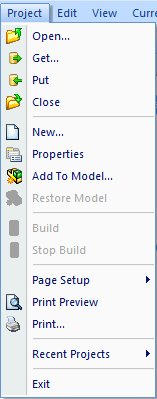
|
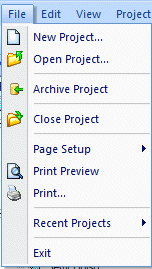 |
| The former Project menu on the left is replaced by the new File menu. | |
Project/Get… and Project/Open… have been replaced by the single menu item File/Open Project… Choosing File/Open Project… presents the Open Project dialog:
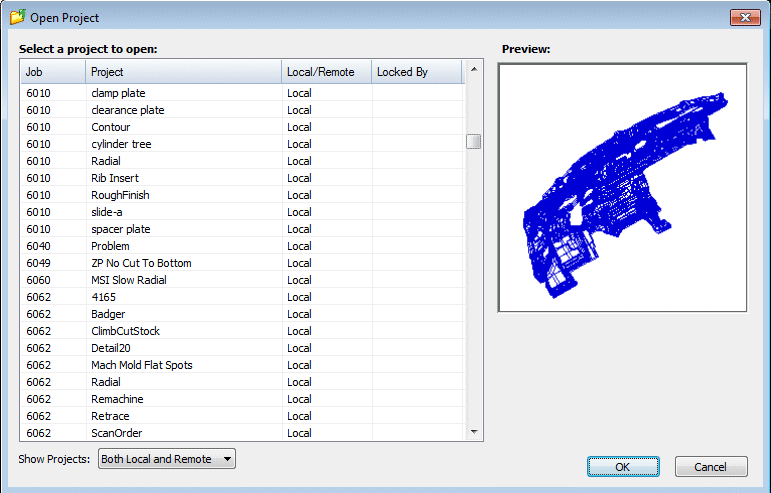 |
| New Open Project Dialog |
Each row in the table represents one Prospector project. The columns in the dialog provide all the relevant information about that project:
| Column | Description |
|---|---|
| Job | The job number assigned to this project. Just as before, each Job is a unique identifier (file folder) which means there can never be 2 jobs of the same name. |
| Project | Individual project(s) associated with a Job number. As in previous releases, there can be any number of individual projects associated with a single job number. |
| Local/Remote | Indicates whether or not the project is in archive form or local to this computer. In previous releases, you would use Project/Get to retrieve a project in archive format from the directory associated with the Remote Jobs directory or Project/Open to open a job that is already local to the computer. The Open Project dialog performs both functions. |
| Locked By | If the project is being worked, this column will show which computer/user has that project. |
Clicking a column header will cause the list to be sorted by the contents of the column.
The Show Project menu at the bottom of the dialog filters the display in the Open Project dialog to show both Remote and Local jobs, Local Only or Remote Only.
File/Archive Project replaces Project/Put. When you are finished working on a project and wish to off-load the data from your computer to the remote jobs directory, choose this menu item to put the project in archive format (.prz file format) and send it to the designated remote directory for the project.
For clarity, the File/New Project… replaces the old Project/New… and File/Close Project replaces Project/Close. The new menu items perform the same function as their predecessors.
The remaining items from the former Project menu have migrated to the new Project menu:
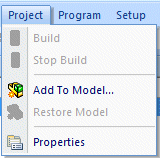 |
The new Project menu contains items related to the current project you are working on in Prospector.
These menu items perform the same function as the entries in the former Project menu. |
File-Based Projects
Project-based organization has historically organized data in a fashion commonly used by mold shops. This level of organization offered a hierarchy of 2 levels:
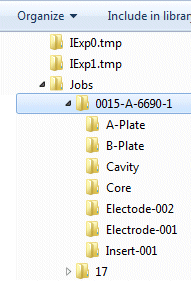 |
Each job – 0015-A-6690-1 in this example – would refer to a single tool to be manufactured. Inside a job directory for a tool would be individual projects needed to machine the different components for that tool. This would include core, cavity, electrodes (if any), lifters, …. |
This form of data organization is designated Project-Based and is the default for customers upgrading from a previous version of Prospector.
For shops who require a deeper hierarchy of data organization, Prospector now allow File-Based project organization. To enable File-Based organization, use PowerSource Insight and change the settings in the Applications Settings / Project-Based Interface folder:
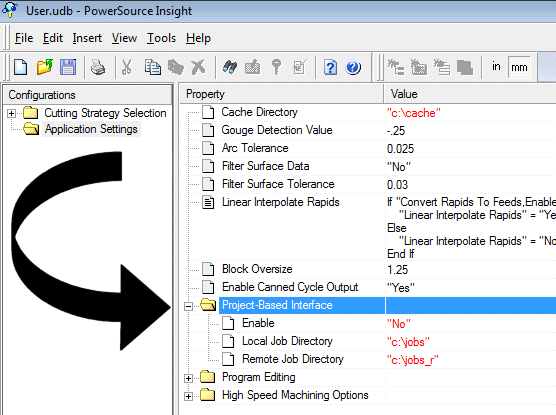 |
| The Project-Based Interface Setting in PowerSource Insight |
As shown above, disable the Project-Based interface by setting the Enable switch to “No”. In the File-Based interface, the Local Job Directory and Remote Job Directory settings are ignored because the File-Based interface allows projects to be created and archived anywhere in the file system.
When you create a new project in the File-Based user interface, you will choose the folder for the project:
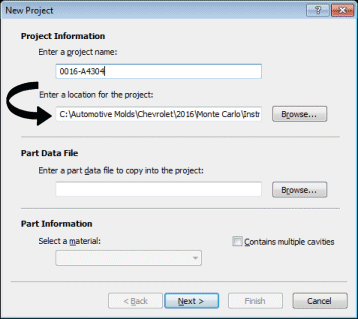 |
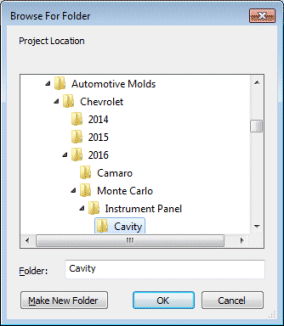 |
| Choose a folder where this project will be created… | The folder for a project can be anywhere in the file system. Create a new folder if needed. |
Aside from choosing the location of a project, the process of creating a new project is the same in both File-Based and Project-Based user interfaces.
The project name entered will be the name of the project file created in the directory selected:
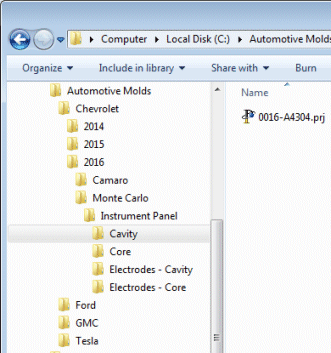 |
In this example, the project data is contained in the file named 0016-A4303.prj in the specified directory.A project file (.prj extension) contains all the data associated with machining this project (part data file, programs, attachments, ...).What a .doc or .docx file is to Microsoft Word, a .prj file is to Prospector.It’s that simple! |
Important Technical Note: Inside the directory you designate for the project, a hidden directory if the same name of the project is created by Prospector to store data files that are created while working on a project. Do not delete this hidden folder or any files in it. Doing so would corrupt the project and make it unusable.
When you are finished machining this project, you can and should archive it by choosing File/Archive Project:
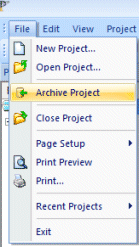 |
Archive Project gathers together all the data files associated with the project that are currently saved in the hidden subdirectory, compresses the data and stores the result in a single file: <project name>.przThe <project name>.prj file is removed. The hidden directory associated with this project is also removed.Archiving a project when you no longer need it is a good way to conserve disk space.Choose File/Open Project to reopen a project (.prj) or an archived project (.prz) file. |
You cannot mix and match Project-Based and File-Based projects! If you choose to use the File-Based project scheme, you cannot open projects that were created using the project-Based scheme. In the Project-Based user interface, you cannot open a project that was created using the File-Based user interface.
The default in Prospector is File-Based user interface. That means that if you are installing on a new computer that did not have Prospector installed on it previously, you will default File-Based. If this is not wanted, make sure to edit the databases in PowerSource Insight or copy an existing database to the new computer you are setting up to switch to the Project-Based user interface.
If the computer you are installing on already has a previous release of Prospector, the default will be Project-Based because it will use your existing databases. If you wish to switch to File-Based, you will need to edit the database in PowerSource Insight.
If you switch to the new File-Based user interface, then find that you need to work on an older project that was created using the Project-Based scheme, start PowerSource Insight and enable the Project-Based Interface in the Application Settings folder.
3D Programming
Z-Planar Remachining has been revised to correct an error where in certain cases the tool would not descend to lower levels of a pocket region when it could clearly go deeper to remove the remaining stock.
Remachining has been revised to filter out unwanted paths for the 2nd and subsequent tools such that the paths that are not sufficiently long to be considered viable are removed then the paths are filtered to remove those that do not cut the minimum number of levels specified. This is a reverse of the filtering order performed by previous versions and produces more efficient programs.
In discrete cases where a very small step down (e.g. .002”) it was possible that a 3D Z-Planar No Clear program could skip areas of the part data that should have been machined. A revised algorithm to sort the intermediate data has been implemented to correct this problem.
The Machine Floors option for Z-Planar With Clear has been corrected to produce proper results if only a single level was specified to be machined. In previous versions, the level would be machined twice.
2D Programming
Specifying Machining Order for Holemaking
A new ordering feature has been added for drilling to allow for the selection of where to start and the direction in which to machine. On the Finish page of the new program wizard, you can now choose Use-Specified ordering:
 |
Choose User-Specified to customize the sequence in which holes are machined. |
When Drill Order is set to User-Specified, you need to set the Drill Start Quadrant and Drill Cut Direction. For any group of holes, the table below describes the machining order:
| Drill Start Quadrant | Drill Cut Direction | Results |
|---|---|---|
First Quadrant |
X-Major |
Start at the hole in the upper right corner. Machine the remaining holes in strips back and forth along the X-axis working from the top to the bottom in Y. |
First Quadrant |
Y-Major |
Start at the hole in the upper right corner. Machine the remaining holes in strips up and down the Y-axis working from the right to the left side of the set of holes. |
Second Quadrant |
X-Major |
Start at the hole in the upper left corner. Machine the remaining holes in strips back and forth along the X-axis working from the top to the bottom in Y. |
Second Quadrant |
Y-Major |
Start at the hole in the upper left corner. Machine the remaining holes in strips up and down the Y-axis working from the left to the right side of the set of holes. |
Third Quadrant |
X-Major |
Start at the hole in the lower left corner. Machine the remaining holes in strips back and forth along the X-axis working from the bottom to the top in Y. |
Third Quadrant |
Y-Major |
Start at the hole in the lower left corner. Machine the remaining holes in strips up and down the Y-axis working from the left to the right side of the set of holes. |
Fourth Quadrant |
X-Major |
Start at the hole in the lower right corner. Machine the remaining holes in strips back and forth along the X-axis working from the bottom to the top in Y. |
Fourth Quadrant |
Y-Major |
Start at the hole in the lower right corner. Machine the remaining holes in strips up and down the Y-axis working from the right to the left side of the set of holes. |
Prospector Design and 3D Printing
3D printing is a process of creating a finished part by laying down one layer of material at a time. The software applications that are used to create the output data that drives 3D printers take as input a 3D model in either STL format or AMF format. Both STL and AMF data formats represent a mesh of the part data. This mesh consists of a set of very small triangles that approximate the actual surface of the model. When you view the part data in Prospector or Prospector Design as a shaded image, you are actually looking at a triangulated mesh of the model. From the mesh in the STL or AMF file, the software provided by the 3D printer vendor cuts sections through the data to find the regions that need to be filled with material for each layer.
In Prospector Design you can choose to output either STL or AMF data:
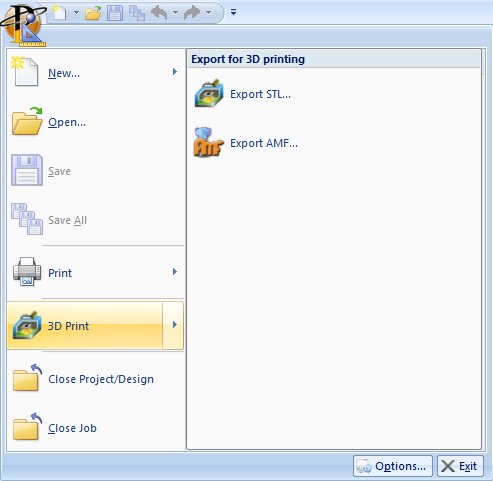 |
STL data is an ASCII format that contains only the triangles that approximate the design. These STL files can be quite large.AMF data not only contains the triangles but also the color information. AMF data is a compressed format to save disk space.The choice of STL or AMF is largely governed by which format your 3D printer software will accept. |
PowerSource System
The default rule in the PowerSource database for choosing a tool for a 3D Z-Planar No Clear has been corrected work properly for data sets that are physically very small in size. Previous versions could issue an error message complaining that the corner radius of the tool was too small in relation to the tool diameter.
The default PowerSource rule for Z-Planar No Clear Island Offset Distance has been revised to put limits on the default. 10% of the tool diameter is used as a default but this can never be greater than 0.1” (.25 mm) or less than .01” (.25 mm). This prevents the cutter from coming dangerously close to an island during retracing in cases where a very small tool diameter is in effect.
A number of program properties did not allow the option to lock them in the system database. All PowerSource program properties have been reviewed and updated to allow them to be locked if needed.
Choosing Help from either PowerSource Insight or Tooling will present the HTML help for that application. Previous versions would present the Prospector HTML help home page instead of the correct documentation for the application.
Corrections and Maintenance
The selection of a program in the program tree control could get out of synch if a tooltip was displayed by the tree control.
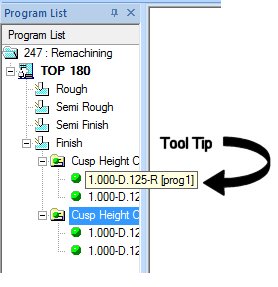
|
When the length of an item in the tree control exceeds the width of the control, a tooltip note as shown here is displayed.In previous versions, when this note was displayed, the actual selection in the tree control could get out of synch with what is shown on the screen.In other words, the program you might have selected (or thought you did because it was highlighted) may not be the actual one that was selected.This problem has been corrected so that the select program(s) are always shown in their proper highlighted state regardless of whether or not a tooltip note is shown as well. |
2D profiling and pocketing has been revised to produce a single pass when the start Z and end Z coordinates are the same. In previous versions it was possible that more than one pass could be created due to double-precision rounding errors 8 or more places to the right of the decimal point when only a single pass at the start Z was intended.
The IGES translator has been revised to handle entities which have associated with them a transformation matrix (e.g. singular subfigures) properly. In previous versions the transformation was being applied twice resulting in incorrectly placed entities.
Application of the plunge feed rate is done in the same manner regardless of the cutting direction (+Z or –Z) for 3D Z-Planar No Clear. The previous version did not apply the plunge feed rate properly when cutting in the +Z direction.
A multi-threading programming error has been corrected could cause the remaining stock model to be out of synch with the actual program data if a program was post processed during program generation.
A program crash or corruption of the remaining stock model could occur in situations where Prospector is currently generating a program a program is post processed using one or more of the high speed machining (HSM) options. During program generation HSM options are temporarily disabled to prevent conflicts. In the HSM dialog, a message to this effect is presented. When program generation concludes, the HSM options will once again be available for post processing.
The Export Settings feature of Prospector has been revised to function correctly for Windows 8 and Windows 8.1. Changes to the operating system prevented the settings from being extracted from the Windows registry.
A command line option - /silver – has been added to Prospector to force it to consume a license for the Silver edition in the event there is a choice of Gold or Silver license(s).
Each time you start prospector, it will automatically check if there is an update available for download and installation over the internet. If there is, a dialog will be presented to offer you the option of downloading and installing the update. If you wish to disable this feature, disable the automatic update feature in the Help menu:
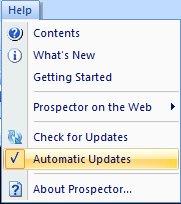 |
| The menu item for enabling/disabling automatic updates. |
Support has been added for mouse events that were previously not supported:
Shift Key + Mouse Wheel = Pan left and right
Ctrl Key + Mouse Wheel = Pan up and down
Alt Key + Mouse Wheel = Rotate about the X-axis of the current view
Alt Key + Shift Key + Mouse Wheel = Rotate about the Y-axis of the current view
Alt Key + Ctrl Key + Mouse Wheel = Rotate about the Z-axis of the current view
Tilt Mouse Wheel = Pan left and right
X button 2 (front button on the side of the mouse) = Go to the next position of the current program
X button 1 (rear button on the side of the mouse) = Go to the previous position of the current program
Note that both Prospector Design and Prospector have been revised to handle the mouse events in the same manner.
Resolved Incident and Enhancement Report
When you report a problem or request an enhancement by contacting our customer service team or reporting a problem at the web portal AMT OnTime you will receive a unique ID for each problem and/or requested enhancement. When we complete a release all incidents and enhancements that were addressed for that particular release are assigned a closed status. The following table lists the closed records for this release.
Record ID |
Synopsis |
|---|---|
| AMT0002 | Missing and out of place surfaces result when this IGES file is used for the part data. |
| AMT00111 | The default rule for choosing a tool does not work well for very small part data sets when creating 3D Z-Planar No Clear programs. |
| AMT00114 | Application of the plunge feed rate is done in the same manner regardless of the cutting direction (+Z or –Z) for 3D Z-Planar No Clear. |
| AMT00157 | Cutter radius compensation option was not being presented certain dialogs. |
| AMT00167 | A number of program settings in PowerSource Insight are not allowed to be locked in the system database. |
| AMT00177 | Remaining stock model data can become out of synch with the NC programs if a program is post-processed during program generation. |
| AMT00189 | Revised the installation program to automatically uninstall a previous version of Prospector when 2014 is installed. |
| AMT00192 | 3D Z-Planar Remachining is not machining lower levels of certain pocket areas of this job. |
| AMT00193 | Certain progress dialog are not using the same font as the other dialogs in Prospector. |
| AMT00197 | When choosing Help from PowerSource Insight or PowerSource Tooling, the help for that application will be shown instead of the home page for Prospector help. |
| AMT00202 | Z-Planar No Clear program is not machining the entire part. |
| AMT00203 | The preview image for Prospector projects has been revised to always produce a shaded image of the part data if possible. |
| AMT00204 | The default viewing mode in Prospector has been changed from wireframe to shaded to be consistent with Prospector Design. |
| AMT00212 | Export Settings feature in Prospector is not working properly on the Windows 8 platform. |
| AMT00213 | 3D Z-Planar Remachining is not machining lower levels of certain pocket areas of this job. |
| AMT00214 | Add the ability to specify the start and order of drilling programs. |
| AMT00217 | Add a command line option to force Prospector to use a silver edition license. |
| AMT00218 | A warning dialog will be posted on program start if the license for Prospector is within 10 days of expiry. |
| AMT00220 | Remaining stock model data can become out of synch with the NC programs if a program is post-processed during program generation. |
| AMT00223 | Remaining stock model data can become out of synch with the NC programs if a program is post-processed during program generation. |
| AMT00224 | Revise the installation program to create the directory Custom Posts under the ProgramData folder. |
| AMT00225 | Using High Speed Machining options can cause a program crash or corruption of the remaining stock model during program generation. |
| AMT00226 | When opening a project permit the selection of a material that also has a configuration for the units the project was created with. |
| AMT00227 | Z-Planar remachining program is gouging the part data. |
| AMT00231 | 2D pocketing and profiling can create 2 passes at the same level when only a single pass is required. |
| AMT00232 | The Machine Floors option for Z-Planar With Clear can cause a single level to be machined twice if the start Z and end Z for the program are the same. |
| AMT00233 | Have Prospector automatically check if an update is available for download when the program is started. |
| AMT00237 | Resetting any or all of the toolbars can cause the icons in the toolbars to disappear. |
| AMT00238 | A level is being skipped in this Z-Planar Remachining sequence. |
| AMT00240 | Add support for other mouse events. |
| AMT00241 | Export Setting feature does not work on Windows 8.1 unless the login has Administrator rights. |
| AMT00242 | Make Prospector and Prospector Design work consistently with respect to how they handle mouse buttons and mouse wheel events. |
| AMT00247 | This Z-Planar remachining program is not honoring the Minimum Levels in Group setting. |
| AMT00248 | The License directory under ProgramData is not being created by the installation program. |
| AMT00250 | Z-Planar No Clear program is gouging the part data. |
| AMT00251 | Revised the island offset distance rule in PowerSource to limit the value to between .01" and .1". |
| AMT00254 | Update the warning message about supported data file to include Parasolid and AutoCAD. |
| AMT00259 | Add the ability to export data from Prospector Design in a format that can be 3D printed. |
| AMT00264 | The tooltip in the program tree can cause the user to load or post process the wrong program. |
